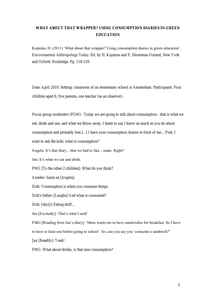This study was motivated by a desire to help working-age individuals gain a better understanding of their daily nutritional intakes with a new self-reported dietary assessment method because an unhealthy eating behavior increases the risks of developing chronic diseases. In this study, we present the design and evaluation of NutriColoring, a food diary that leverages doodling on sketches to report and reflect on everyday diet in the working context. Through a 2-week field study involving 18 participants, the usefulness of NutriColoring in facilitating dietary assessment was tested by making comparisons with the typical bullet diary method. Our quantitative results showed that NutriColoring provided users with improved dietary assessment experience and intrinsic motivations, with significantly low task frustration and high enjoyment. Because of the freedom and playfulness in reporting intakes at work, the interview findings showed a high acceptance of employing NutriColoring at work. This article is concluded with a set of implications for the design and development of a Doodling toolkit to support healthy eating behaviors among office workers.
DOCUMENT

Environmental or ‘green' education is an important driving force behind the ‘greening' of society as it plays a critical role in raising environmental awareness and preparing students for green jobs. None of the existing environmental attitudes and behavior measures is focused on the evaluation of green education, especially in relation to consumption. To date, no longitudinal studies of children and students' attitudes towards consumption influenced by education exist. Also, little has been done to explore the socio-cultural context in which attitudes toward consumption are being formed and to explain the cross-cultural differences in environmental attitudes. This pilot study is designed to take the first step towards developing methods complementing existing quantitative measurements with qualitative strategies, such as consumption diaries, focus groups, and concept mapping. While this research is just a first attempt to tackle children's knowledge and attitudes consumption, preliminary results of the research on which this chapter is based and enthusiasm of the research participants encourage the author to stress the importance of consumption studies as part of green education for educational program developers. As a chapter of this volume, the author hopes that this study will add to the anthropological depository of research on the cultural variants in the perception of the environment in children. This chapter draws upon the consumption diaries collected from the upper-elementary school children in Amsterdam, The Netherlands, between September 2009 and May 2010. Consumption diaries are chronological documents recording purchase, use, and waste of materials, which can be used both as analytical tools and the means to stimulate environmental awareness. The four main methodological steps involved in this research were as follows. Children were asked to complete the consumption diary, paying specific attention to use and waste materials. Consequently, focus group meetings were held with parents and their children to discuss the diaries. Finally, interviews with the children were conducted in order to generate statements that supplement those generated by focus groups for carrying out the concept mapping analysis. The concept mapping analysis was then conducted to organize the order and analyze the ideas expressed in the focus group and interview sessions. This is an Accepted Manuscript of a book chapter published by Routledge/CRC Press in "Environmental Anthropology Today" on 8/5/11 available online: https://doi.org/10.4324/9780203806906 LinkedIn: https://www.linkedin.com/in/helenkopnina/
MULTIFILE

ObjectiveTo determine the effectiveness of the “Plants for Joints” multidisciplinary lifestyle program in patients with metabolic syndrome-associated osteoarthritis (MSOA).DesignPatients with hip or knee MSOA were randomized to the intervention or control group. The intervention group followed a 16-week program in addition to usual care based on a whole food plant-based diet, physical activity, and stress management. The control group received usual care. The patient-reported Western Ontario and McMasters Universities Osteoarthritis Index (WOMAC) total score (range 0–96) was the primary outcome. Secondary outcomes included other patient-reported, anthropometric, and metabolic measures. An intention-to-treat analysis with a linear-mixed model adjusted for baseline values was used to analyze between-group differences.ResultsOf the 66 people randomized, 64 completed the study. Participants (84% female) had a mean (SD) age of 63 (6) years and body mass index of 33 (5) kg/m2. After 16 weeks, the intervention group (n = 32) had a mean 11-point larger improvement in WOMAC-score (95% CI 6–16; p = 0.0001) compared to the control group. The intervention group also lost more weight (–5 kg), fat mass (–4 kg), and waist circumference (–6 cm) compared to the control group. Patient-Reported Outcomes Measurement Information System (PROMIS) fatigue, pain interference, C-reactive protein, hemoglobin A1c, fasting glucose, and low-density lipoproteins improved in the intervention versus the control group, while other PROMIS measures, blood pressure, high-density lipoproteins, and triglycerides did not differ significantly between the groups.ConclusionThe “Plants for Joints” lifestyle program reduced stiffness, relieved pain, and improved physical function in people with hip or knee MSOA compared to usual care.
MULTIFILE
